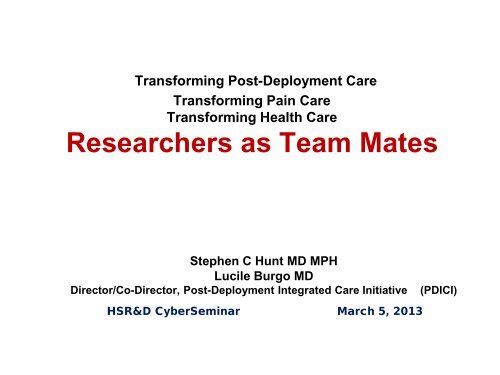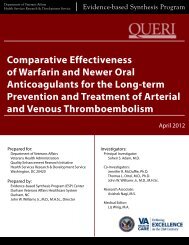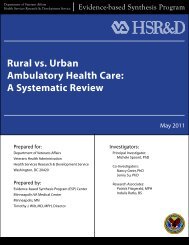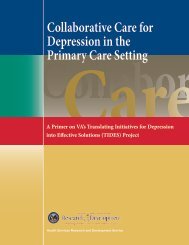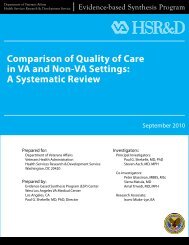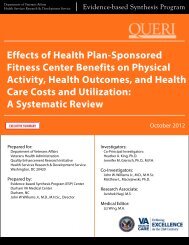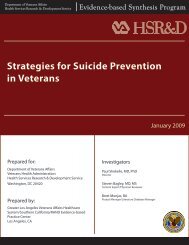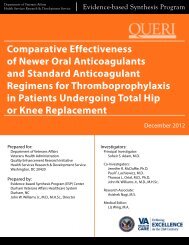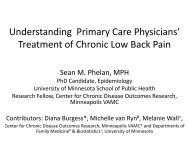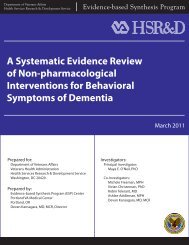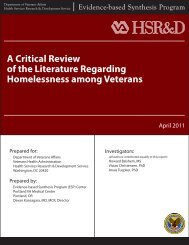PDF handout - HSR&D
PDF handout - HSR&D
PDF handout - HSR&D
You also want an ePaper? Increase the reach of your titles
YUMPU automatically turns print PDFs into web optimized ePapers that Google loves.
Transforming Post-Deployment Care<br />
Transforming Pain Care<br />
Transforming Health Care<br />
Researchers as Team Mates<br />
Stephen C Hunt MD MPH<br />
Lucile Burgo MD<br />
Director/Co-Director, Post-Deployment Integrated Care Initiative<br />
(PDICI)<br />
HSR&D CyberSeminar March 5, 2013<br />
1
Poll Question #1<br />
• What is your primary role in VA? (128 character limit for the<br />
question)<br />
– student, trainee, or fellow (60 character limit for each answer choice)<br />
– clinician<br />
– researcher<br />
– manager or policy-maker<br />
– Other<br />
Up to five answer options. Can be “select one” or “select all that apply”
Poll Question #1<br />
• Do you have a role in PACT? (128 character limit for the<br />
question)<br />
– Teamlet member(60 character limit for each answer choice)<br />
– Expanded PACT member<br />
– manager or policy-maker<br />
– Other<br />
Up to five answer options. Can be “select one” or “select all that apply”
HSR&D<br />
Health Services Research and Development<br />
…research that underscores all aspects of VA healthcare: patient care,<br />
care delivery, health outcomes, cost, and quality as well as critical<br />
issues for Veterans returning home from Iraq and Afghanistan with<br />
conditions that may require care over their lifetimes.<br />
Within VA HSR&D, researchers focus on identifying and evaluating<br />
innovative strategies that lead to accessible, high quality, costeffective<br />
care for Veterans and the nation
Transforming Post-Deployment Care
We knew that the health risks of<br />
combat were many…
…and that the health impacts were prevalent…<br />
1,557,026 of the 2.5 million deployed, are separated and<br />
eligible for VA<br />
56 % (866,182) have been seen in VA between FY02 and<br />
October 1, 2012<br />
• Musculoskeletal 57.5%<br />
• Mental disorders 53.6%<br />
• Symptoms/signs 52.8%<br />
• Nervous system (hearing) 45.8%<br />
• GI (dental) 36.2%<br />
• Endocrine/Nutrition 33.3%<br />
• Injury/Poisoning 29.0%<br />
• Respiratory 26.5%<br />
VHA Office of Public Health and Environmental Hazards<br />
Released: January 2013<br />
7
…and complex…<br />
Lew, Otis, Tun, Kerns, Clark, & Cifu, JRR&D; 2009<br />
Sample = 340 OEF/OIF outpatients at Boston VA<br />
TBI/Pain<br />
12.6%<br />
Overall prevalence:<br />
Pain 81.5%<br />
TBI 68.2%<br />
PTSD 66.8%<br />
5.3%<br />
CLARK- 2009<br />
6.8%<br />
P3 Multi-symptom<br />
Disorder<br />
42.1%<br />
PTSD<br />
2. %<br />
10.3%<br />
16.5%
We had learned a great deal from our<br />
experiences with Veterans from earlier<br />
conflicts…
Rate the degree to which you<br />
P<br />
e<br />
r<br />
c<br />
e<br />
n<br />
t<br />
believe<br />
“Persian Gulf Illness” is:<br />
Richardson RD, Engel CC, McFall, M,<br />
McKnight K, Hunt SC. Clinician<br />
Attributions for Symptoms and<br />
Treatment of Gulf War-Related Health<br />
Concerns. Archives of Internal<br />
Medicine 2001; 161: 1289-1294.
P<br />
e<br />
r<br />
c<br />
e<br />
n<br />
t<br />
Rate the degree to which you believe<br />
“Persian Gulf Illness,” in general,<br />
is most effectively treated by:<br />
Richardson RD, Engel CC, McFall, M,<br />
McKnight K, Hunt SC. Clinician<br />
Attributions for Symptoms and<br />
Treatment of Gulf War-Related Health<br />
Concerns. Archives of Internal<br />
Medicine 2001; 161: 1289-1294.
We knew that there were<br />
physical<br />
risks and impacts of combat…<br />
injury<br />
temperature<br />
diet<br />
toxic agents<br />
multiple immunizations<br />
noise<br />
sleep deprivation<br />
austere conditions<br />
infectious agents<br />
blast wave/head injury
We knew that there were<br />
psychological<br />
risks and impacts of combat…<br />
anticipation of combat<br />
combat trauma<br />
non-combat trauma<br />
separation from family/home<br />
deprivation
We knew that there were<br />
psychosocial<br />
risks and impacts of combat…<br />
Marital/parenting issues<br />
Social functioning<br />
Occupational/financial concerns<br />
Risk of re-deployment<br />
Spiritual / existential
Primary Care-Mental Health Integration<br />
(Primary Care Mental Health Integration Initiative 2007)<br />
PCP<br />
Veteran<br />
MH<br />
Provider
PDICI (Post-Deployment Integrated Care Initiative 2008)<br />
Physical<br />
Psychological<br />
Veteran<br />
Psychosocial
Integrated Post-Combat Care<br />
PDICI (Post-Deployment Integrated Care Initiative 2008)<br />
Primary Care<br />
Provider<br />
Veteran<br />
Mental Health<br />
Provider<br />
Social Worker
MAJORITY OF OEF/OIF VETERANS RECEIVE THEIR INITIAL<br />
PRIMARY CARE CLINICAL EVALUATION WITH THE…<br />
OEF/OIF Post Deployment Clinic 54%<br />
OEF/OIF Primary Care Cohort 34%<br />
General Primary Care Clinic(s) 12%<br />
QuERI: Mittman, Wyte, MacGregor
AS PART OF THE INITIAL CLINICAL EVALUATION<br />
PROCESS FOR OEF/OIF VETERANS…<br />
…a mental health<br />
specialist typically<br />
conducts a separate<br />
evaluation and/or combat<br />
stress assessment<br />
…a social worker/case<br />
manager typically<br />
conducts a separate<br />
evaluation<br />
48%<br />
87%<br />
QuERI: Mittman, Wyte, MacGregor
…and were learning in real time…
1st Quarter FY 2002 through 4nd Quarter FY 2011<br />
Office of Public Health and Environmental Hazards December 2011<br />
26
Am J Psychiatry 159:12, December 2002
What are the stressors of war?<br />
Psychosocial<br />
Marital/parenting issues<br />
Social functioning<br />
Occupational/financial concerns<br />
Risk of re-deployment<br />
Spiritual / existential
Transforming Veterans Pain Care<br />
Implementation of the Pain Directive<br />
•<br />
1. Education of Veterans<br />
2. Education and training of Teams<br />
3. Establish primary care Pain Champion, pain resource providers,<br />
pain teams (pain resource nurse, pain resource pharmacist, pain<br />
psychologist)<br />
4. Development of non-pharmacological modalities<br />
5. Strengthen capacity for connecting the specialists with the<br />
PACTs: e consult, ECHO/SCAN, telephone consult services,<br />
Office Communicator<br />
6. Instituting safe opioid prescribing (universal precautions, opioid<br />
surveillance)<br />
7. Metrics/dashboards to monitor and maintain pain care<br />
•<br />
35
Transforming Veterans Pain Care<br />
Implementation of the Pain Directive<br />
•<br />
1. Education of Veterans<br />
2. Education and training of Teams<br />
3. Establish primary care Pain Champion, pain resource providers,<br />
pain teams (pain resource nurse, pain resource pharmacist, pain<br />
psychologist)<br />
4. Development of non-pharmacological modalities<br />
5. Strengthen capacity for connecting the specialists with the<br />
PACTs: e consult, ECHO/SCAN, telephone consult services,<br />
Office Communicator<br />
6. Instituting safe opioid prescribing (universal precautions, opioid<br />
surveillance)<br />
7. Metrics/dashboards to monitor and maintain pain care<br />
•<br />
36
Transforming Veterans Pain Care<br />
Implementation of the Pain Directive<br />
•<br />
1. Education of Veterans<br />
2. Education and training of Teams<br />
3. Establish primary care Pain Champion, pain resource providers,<br />
pain teams (pain resource nurse, pain resource pharmacist, pain<br />
psychologist, BH support/HBC)<br />
4. Development of non-pharmacological modalities<br />
5. Strengthen capacity for connecting the specialists with the<br />
PACTs: e consult, ECHO/SCAN, telephone consult services,<br />
telehealth, Office Communicator<br />
6. Instituting safe opioid prescribing (universal precautions, opioid<br />
surveillance)<br />
7. Metrics/dashboards to monitor and maintain pain care<br />
•<br />
37
Transforming Veterans Pain Care<br />
Implementation of the Pain Directive<br />
•<br />
1. Education of Veterans<br />
2. Education and training of Teams<br />
3. Establish primary care Pain Champion, pain resource providers,<br />
pain teams (pain resource nurse, pain resource pharmacist, pain<br />
psychologist)<br />
4. Development of non-pharmacological modalities<br />
5. Strengthen capacity for connecting the specialists with the<br />
PACTs: e consult, ECHO/SCAN, telephone consult services,<br />
Office Communicator<br />
6. Instituting safe opioid prescribing (universal precautions, opioid<br />
surveillance)<br />
7. Metrics/dashboards to monitor and maintain pain care<br />
•<br />
38
The Old Paradigm: Veteran needs specialist<br />
Specialty<br />
Provider<br />
Specialty consult<br />
disposition/plan<br />
recorded in note<br />
Consult sent to<br />
Specialty Clinic<br />
PCP
The Old Paradigm: Veteran needs specialist<br />
Specialty<br />
Provider<br />
Specialty consult<br />
disposition/plan<br />
recorded in note<br />
Consult sent to<br />
Specialty Clinic<br />
PCP
The Pain Specialist and the Expanded PACT<br />
Team<br />
What level of<br />
specialty input does<br />
the Veteran need and<br />
how do we best<br />
connect, collaborate<br />
and coordinate?<br />
Specialty<br />
Provider<br />
PACT<br />
teamlet
The Specialist and the Expanded PACT Team<br />
Level 3:<br />
Veteran and PACT team<br />
need input from specialist<br />
but not necessarily a<br />
Veteran visit with the<br />
specialist<br />
•f/u on Pain<br />
assessment<br />
•Pain/PTSD/other<br />
co-morbidity<br />
Specialty<br />
Provider<br />
PACT<br />
teamlet<br />
Team function:<br />
•Documentation on<br />
over-arching treatment<br />
plan<br />
•Non-visit consult note<br />
•Specialist has direct<br />
communication with team:<br />
•Tele-conference<br />
•SCAN<br />
•Office Communicator<br />
day of visit
The Specialist and the Expanded PACT Team<br />
Level 2:<br />
Veteran needs specialized<br />
care that is best delivered in<br />
a more collaborative setting<br />
•Pain with/without PTSD<br />
•rehab/pain issues<br />
•Health recovery rehab Plan<br />
•CBT, brief behavioral<br />
interventions<br />
Specialty<br />
Provider<br />
PACT<br />
teamlet<br />
Team function:<br />
•Documentation on<br />
over-arching treatment<br />
plan<br />
•Specialist has direct<br />
communication with PCP:<br />
•Telephone call<br />
•Secure e mail/text<br />
•OC on day of visit<br />
•Specialist attends team<br />
meeting<br />
•Coordination of care<br />
through specialty clinic<br />
care manager and PACT<br />
RN Care Manager
The Specialist and the Expanded PACT Team<br />
Level 1:<br />
Veteran needs highly<br />
specialized cares that<br />
will be delivered in<br />
the specialty setting:<br />
•Moderate/severe<br />
chronic pain<br />
•Need for interventional<br />
pain care<br />
•High/moderate levels<br />
of general or specialized<br />
rehab, cognitive rehab,<br />
OT, speech tx<br />
Specialty<br />
Provider<br />
PACT<br />
teamlet<br />
Team function:<br />
•Contact between specialist<br />
and PCP<br />
•Documentation on<br />
over-arching treatment<br />
plan<br />
•Coordination of care<br />
through specialty clinic<br />
care manager and PACT<br />
RN Care Manager
PC<br />
P ROVIDER<br />
C LINICAL<br />
A SSOCIATE<br />
C LERK<br />
RN C ARE<br />
M ANAGER<br />
FAMILY<br />
45
Stepped Pain Care<br />
Tertiary Interdisciplinary Pain Centers<br />
Comorbidities<br />
RISK<br />
Advanced diagnostics & interventions<br />
Commission on Accreditation of Rehabilitation<br />
Facilities accredited pain rehabilitation<br />
Integrated chronic pain and Substance Use<br />
Disorder treatment<br />
STEP<br />
3<br />
Treatment<br />
Refractory<br />
Secondary Consultation<br />
Pain Medicine<br />
Rehabilitation Medicine<br />
Behavioral Pain Management<br />
Multidisciplinary Pain Clinics<br />
Substance Use Disorders Programs<br />
Mental Health Programs<br />
STEP<br />
2<br />
Complexity<br />
Patient Aligned Care Team (PACT)<br />
Routine screening for presence & intensity of pain<br />
Comprehensive pain assessment<br />
Management of common acute and chronic pain conditions<br />
Mental Health-Primary Care Integration, Health Behavior<br />
Coordinators, Operation Enduring Freedom/Operation Iraqi<br />
Freedom, & Post-Deployment Teams<br />
Expanded nurse care management<br />
Opioid Renewal Clinics; Pain Schools<br />
STEP<br />
1<br />
46
Transforming Veterans Pain Care<br />
Implementation of the Pain Directive<br />
•<br />
1. Education of Veterans<br />
2. Education and training of Teams<br />
3. Establish primary care Pain Champion, pain resource providers,<br />
pain teams (pain resource nurse, pain resource pharmacist, pain<br />
psychologist)<br />
4. Development of non-pharmacological modalities<br />
5. Strengthen capacity for connecting the specialists with the<br />
PACTs: e consult, ECHO/SCAN, telephone consult services,<br />
Office Communicator<br />
6. Instituting safe opioid prescribing (universal precautions, opioid<br />
surveillance)<br />
7. Metrics/dashboards to monitor and maintain pain care<br />
•<br />
47
Transforming Veterans Pain Care<br />
Implementation of the Pain Directive<br />
•<br />
1. Education of Veterans<br />
2. Education and training of Teams<br />
3. Establish primary care Pain Champion, pain resource providers,<br />
pain teams (pain resource nurse, pain resource pharmacist, pain<br />
psychologist)<br />
4. Development of non-pharmacological modalities<br />
5. Strengthen capacity for connecting the specialists with the<br />
PACTs: e consult, ECHO/SCAN, telephone consult services,<br />
Office Communicator<br />
6. Instituting safe opioid prescribing (universal precautions, opioid<br />
surveillance)<br />
7. Metrics/dashboards to monitor and maintain pain care<br />
•<br />
48
We learned from other emerging care models…<br />
Primary Care-Mental Health Integration<br />
(Primary Care Mental Health Integration Initiative 2007)<br />
PCP<br />
Veteran<br />
MH
Transforming Veterans Pain Care<br />
Current Projects<br />
•<br />
1. Current HSR&D Projects and<br />
Initiatives (CREATE)<br />
2. Opioid Safety Initiative<br />
3. Joint DoD/VA Pain Education<br />
Project (JIF JPEP)<br />
2013:The Year of Pain Care<br />
52
Transformation of Veterans Health Care<br />
Care is<br />
customized<br />
to individual’s<br />
needs and<br />
values<br />
Veteran<br />
Centered,<br />
Team<br />
Based<br />
Power<br />
resides<br />
with the<br />
patient<br />
Care based on<br />
continuous<br />
healing<br />
relationships<br />
IOM 2001<br />
Crossing the Quality Chasm
HSR&D Webinar<br />
March 5, 2013<br />
QUESTIONS ?<br />
Stephen.hunt@va.gov<br />
Lucille.burgo@va.gov<br />
Transforming Post-Deployment Care<br />
Transforming Pain Care<br />
Transforming VA Health Care<br />
Researchers as Partners


